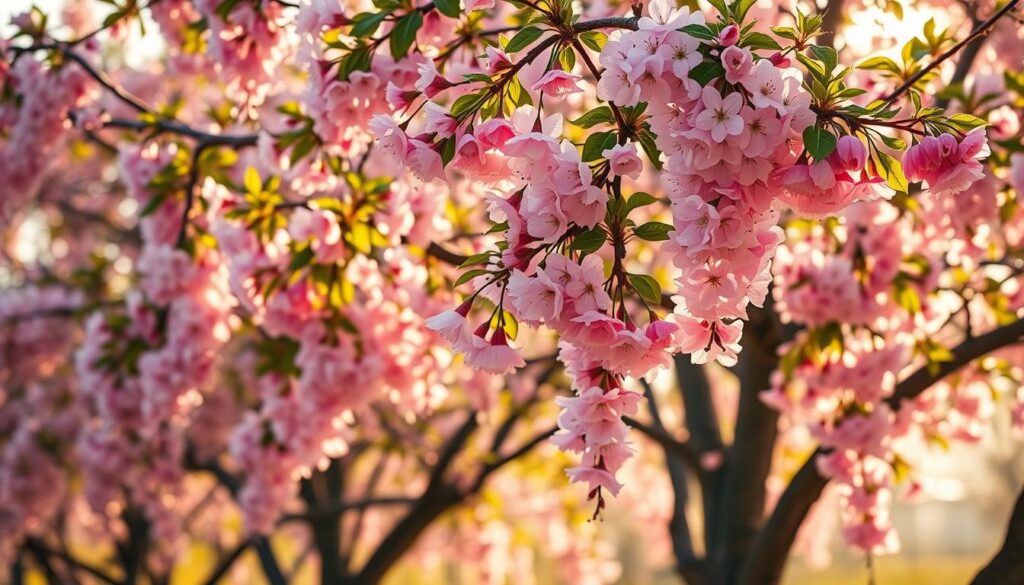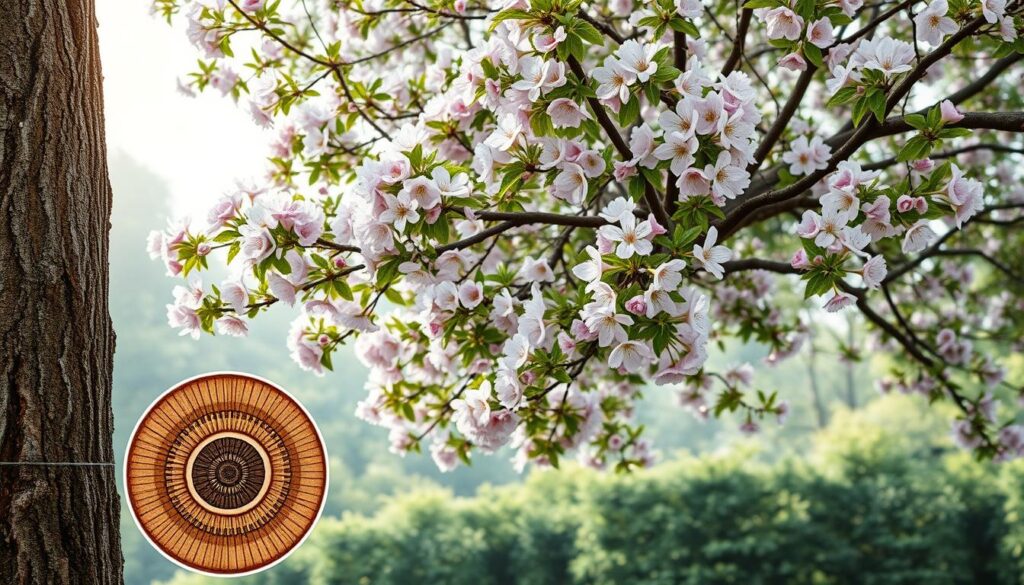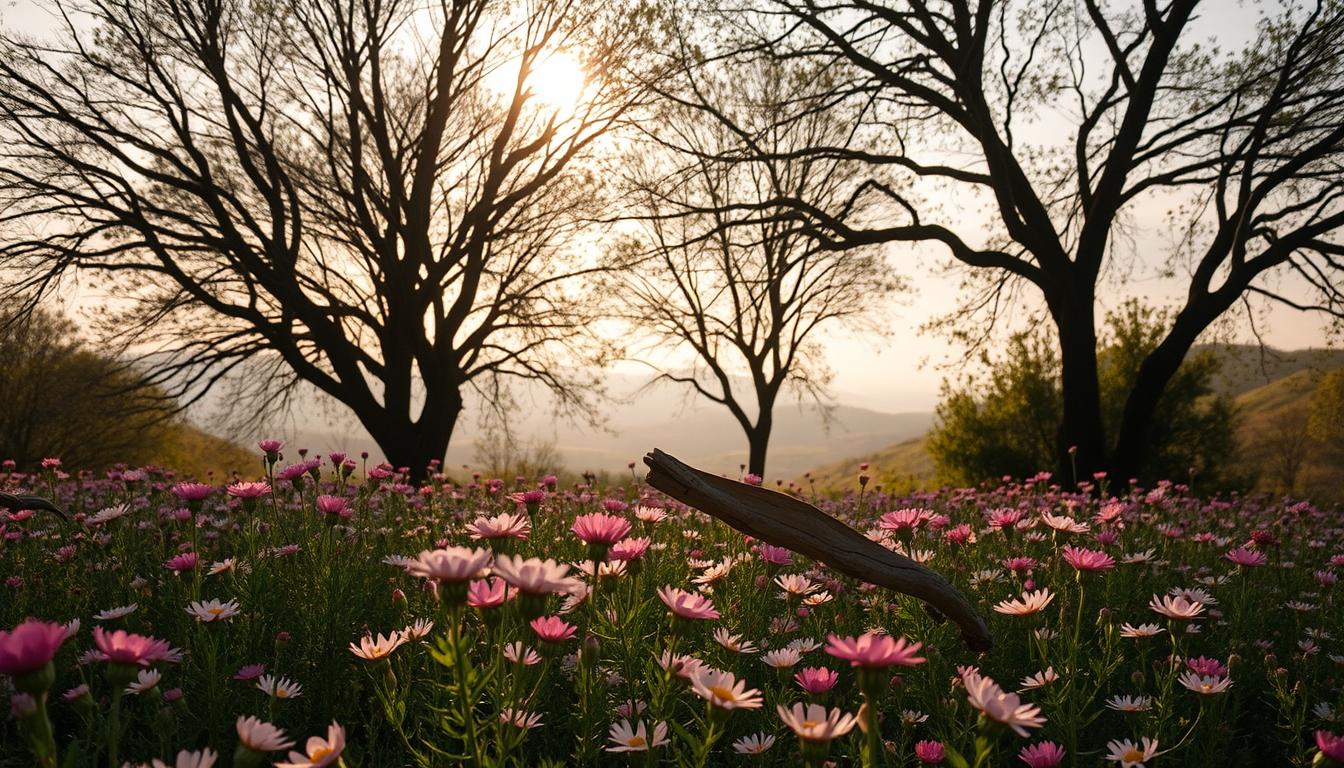Every spring, my backyard turns into a colorful wonderland. This is thanks to the beautiful small tree flowers that bloom. These trees add vibrant colors to even the smallest gardens. They are perfect for anyone who loves gardening or just wants to beautify their yard.
Imagine walking into a garden filled with delicate flowers on small trees. It’s a sight that’s both cozy and grand. Small tree flowers let you create a stunning garden without needing a lot of space. From the charming eastern redbud to the elegant dogwood, these trees show that beauty can be small.
In this guide, we’ll look at 10 amazing small tree flowers that will make your garden stand out. You’ll learn how these trees can turn any outdoor area into a beautiful retreat. They will capture your imagination and calm your soul.
Table of Contents
Understanding Small Tree Flowers in Your Landscape
Dwarf trees turn simple yards into beautiful gardens. These small plants are perfect for making small spaces look great. They add color and life to your garden, making it more than just a pretty view.
Choosing the right flowering trees is key to a great garden. With the right selection, your yard can become a colorful and textured masterpiece.
Benefits of Small Flowering Trees
- Maximize limited garden spaces
- Provide stunning seasonal color
- Attract pollinators like butterflies and bees
- Create natural privacy screens
- Enhance property value and curb appeal
Best Growing Zones and Conditions
Different dwarf trees need different places to grow. Knowing your local USDA hardiness zone is important. Microclimates in your yard can also affect how well trees grow.
Seasonal Blooming Patterns
Knowing when trees bloom helps create a garden that looks good all year. Some trees bloom early in spring, while others bloom late, keeping your garden beautiful longer.
Selecting the right tree transforms your outdoor space from ordinary to extraordinary.
Eastern Redbud: First Signs of Spring
Spring brings magic, and few plants show it like the Eastern Redbud. This tree turns landscapes into a canvas of rosy pink blossoms. It signals the end of winter and the start of nature’s renewal.
The Eastern Redbud is a small tree with big impact. It grows in woodland areas across the United States. Its colorful leaves follow the flowers, creating a stunning spring view.
- Height: 20-30 feet
- Bloom color: Vibrant pink to lavender
- Bloom period: Early to mid-spring
- Sunlight requirements: Full sun to partial shade
Gardeners love this tree for many reasons. Its heart-shaped leaves and small size are great for small yards. It also attracts bees and butterflies with its early spring flowers.
“The Eastern Redbud is nature’s paintbrush, turning landscapes into living watercolors.” – American Gardening Magazine
Think of the Eastern Redbud as a key piece in your garden. It adds beauty and helps the environment. Its easy care and beautiful changes make it a top choice for gardeners.
Dogwood Varieties and Their Stunning Blooms
Dogwood trees are amazing for your garden, with beautiful blooms that change your landscape. They add beauty all year, loved by garden experts and homeowners.
Dogwoods stand out with their special horizontal branches and stunning spring flowers. Their unique look makes them a top choice for gardens.
White Dogwood Characteristics
White dogwood trees are a sight to see with their pure white flowers. They have:
- Pristine white flowers measuring 3-4 inches across
- Elegant, horizontal branch structure
- Mature height of 15-25 feet
- Excellent for small garden spaces
Pink Dogwood Features
Pink dogwood trees add a romantic feel to gardens. They have:
- Delicate pink to rose-colored blossoms
- Compact growth habit
- Outstanding spring flowering performance
- Attractive bark texture
Cherokee Chief Red Dogwood Options
The Cherokee Chief red dogwood is perfect for those who love bold colors. It has deep red to burgundy flowers, adding vibrant color to your garden.
Choosing the right dogwood depends on your garden and what you like. Each variety adds its beauty and charm to your outdoor space.
Magnificent Magnolia: Compact Varieties for Small Spaces
Magnolias aren’t just for big gardens. Dwarf trees bring stunning flowers to small spaces, making them perfect for tiny yards or cozy patios. These elegant plants can change your landscape.
Choosing the right dwarf magnolia is key. They grow 10-20 feet tall, ideal for containers or small gardens. Their big blooms make a statement without taking over.
“Small gardens can bloom big with the right magnolia variety” – Garden Design Expert
- Star Magnolia (Magnolia stellata): Grows up to 15 feet tall and features striking white, star-shaped blooms.
- Saucer Magnolia (Magnolia x soulangeana): Grows 15-20 feet, pink-white blossoms
- Little Gem Magnolia: A compact variety known for its dark green foliage.
For container gardening, use well-draining soil and plenty of sunlight. Most prefer partial sun and a protected spot.
| Magnolia Variety | Height | Bloom Color | Growing Zone |
|---|---|---|---|
| Star Magnolia | 10-15 feet | White | 4-9 |
| Saucer Magnolia | 15-20 feet | Pink/White | 5-9 |
| Little Gem | 20-25 feet | Creamy White | 6-10 |
With the right care, these small flowers can be stunning features in any small outdoor space.
Cherry Blossoms: Decorative Spring Features
Cherry blossoms turn yards into magical places in spring. They make stunning ornamental trees that make yards look better. These trees bring stunning color and a touch of elegance to homes throughout the United States.
When choosing cherry trees for your yard, you’ll find many types. Each has its beauty that can make your outdoor space look amazing.
Kwanzan Cherry Tree Highlights
The Kwanzan cherry tree is a great choice for making your yard beautiful. It’s known for:
- Double-pink blossoms
- Vibrant spring flowering
- Robust growth pattern
- Widespread popularity in the mid-Atlantic regions
Okame Cherry Tree Benefits
Okame cherry trees bloom early in spring and offer numerous advantages:
- Compact size, perfect for smaller yards
- Brilliant coral-pink flowers
- Fast-growing nature
- Adaptable to various climate zones
Weeping Cherry Varieties
Weeping cherry trees add dramatic beauty with their cascading branches. These ornamental trees create stunning focal points in landscape design. They offer graceful silhouettes and plenty of springtime blossoms.
“Cherry blossoms are nature’s poetry, dancing on branches and painting landscapes with delicate beauty.” – Garden Design Magazine
Crabapple Trees: Low-Maintenance Beauty

Crabapple trees are a gardener’s dream. They are low-maintenance and offer stunning beauty. These trees add colorful foliage and breathtaking spring blossoms to your landscape.
Crabapple trees have unique features that enhance your garden. They come in different shapes, such as:
- Compact mounding shapes
- Upright narrow forms
- Graceful weeping structures
Their spring blooms are a sight to see. They feature delicate flowers in white, soft pink, and vibrant red. These trees not only look great but also attract pollinators.
| Crabapple Variety | Flower Color | Size | Wildlife Value |
|---|---|---|---|
| Royal Raindrops | Deep Pink | 20 feet | High |
| Prairifire | Bright Red | 15-20 feet | Moderate |
| Spring Snow | Pure White | 25 feet | High |
“Crabapple trees are nature’s artwork, painting your landscape with seasonal beauty.” – Landscape Design Expert
Modern varieties of crabapple trees are disease-resistant. They stay healthy with little care. Their autumn fruits add beauty and food for wildlife, making them a great choice for any garden.
Small Tree Flowers for Shade Gardens
Creating a vibrant garden in shaded areas can be tough. But many stunning flowering trees do well in low light. Your shade garden can become a beautiful sanctuary with the right plants.
Shade gardens are perfect for those who love garden decor. They offer a chance to explore unique plants that make dim spaces magical. Knowing which plants do best in shade helps you create a lush outdoor space.
Witch Hazel: A Shade Garden Champion
Witch hazel is a top choice for shaded areas. It’s a remarkable shrub with special traits:
- Cold-tolerant and drought-resistant
- Deer-resistant nature
- Adaptable to various soil types
- Unique late-fall or early-spring blooming periods
Understory Blooming Varieties
More flowering trees do well in shade gardens:
- Serviceberry: Delicate white blossoms in spring
- Pawpaw: Interesting maroon flowers
- Dogwood varieties: Elegant shade-loving options
When picking shade-tolerant flowering trees, think about their size, bloom time, and light needs. This way, you can have a garden that looks great all year.
Vibrant Flowering Shrubs for Borders
Make your yard stunning with flowering shrubs that make amazing borders. Viburnums are top picks for gardeners wanting color and structure.
When picking flowering shrubs for your borders, think about these things:
- Seasonal bloom patterns
- Foliage color and texture
- Mature plant size
- Sunlight requirements
Viburnum varieties are great for yard beautification. They have delicate flowers in white to soft pink. These flowers add beauty in spring and early summer.
| Viburnum Variety | Flower Color | Bloom Season |
|---|---|---|
| Doublefile Viburnum | White | Late Spring |
| Korean Spice Viburnum | Pink to White | Early Spring |
| Snowball Viburnum | Pure White | Mid-Spring |
You can mix different flowering shrubs in your border. This adds depth and color. Choose varieties that bloom at different times for a lively landscape all season.
“A well-planned shrub border is like a living painting that changes with each passing week.” – Professional Landscape Designer
Think about your growing zone and soil when picking shrubs. The right spot and care will make your border beautiful for years.
Year-Round Care for Flowering Trees
Keeping your landscaping plants healthy all year is key. Flowering trees add beauty to your garden but need special care. Knowing how to care for them all year will keep your garden looking great.

Tree care is all about knowing what each tree needs. Different trees have different needs to stay healthy and look good.
Essential Seasonal Maintenance Strategies
- Spring: Check trees for winter damage and remove dead branches
- Summer: Keep an eye on watering and watch for pests
- Fall: Mulch trees and check their roots
- Winter: Protect trees from frost and cold weather
Pruning and Shaping Techniques
Pruning is vital for your trees’ health and look. Clean, sharp pruning tools help prevent disease and make clean cuts.
- Remove dead or crossing branches
- Make your cut at a 45-degree angle just above a bud.
- Avoid pruning when they’re blooming
- Sanitize tools between trees
Pro tip: Deadhead flower clusters after blooming to encourage more growth and keep things neat.
By following these care tips, your plants will stay healthy and beautiful all year. They’ll be the highlight of your garden.
Creating Color Combinations with Small Flowering Trees
Creating a beautiful yard with blooming trees requires thoughtful color coordination and strategic placement. Your landscape can become a vibrant canvas. This is done by picking flowering trees that match well and create harmony.
When planning your yard with small flowering trees, keep these color combination tips in mind:
- Pair trees with contrasting bloom colors for dramatic visual impact
- Select trees with sequential blooming periods for continuous color
- Match tree flowers with existing landscape elements
Successful color combinations depend on knowing each tree’s unique traits. Seasonal transitions are key to creating dynamic garden designs.
| Tree Type | Bloom Color | Blooming Season |
|---|---|---|
| Eastern Redbud | Magenta Pink | Early Spring |
| Dogwood | White/Pink | Mid-Spring |
| Crabapple | White/Pink | Late Spring |
Placing blooming trees wisely can make your landscape stand out. By knowing color theory and each tree’s blooming pattern, you can make a yard that looks great all year.
Best Flowering Trees for Different Climate Zones
Choosing the right small tree flowers can make your garden come alive. It’s important to know your local growing conditions. This helps pick ornamental trees that will do well in your area.
The USDA hardiness zones serve as an essential reference for gardeners. They show which small flowering trees will thrive in different temperatures across the U.S. Most trees do best in zones 5 to 9.
- Cold Climate Zones (5-6): Look at hardy options like:
- Eastern Redbud
- Flowering Dogwood
- Serviceberry
- Moderate Climate Zones (7-8): Great for:
- Magnolia
- Fringe Tree
- Crape Myrtle
- Warm Climate Zones (9-10): Best choices are:
- Chaste Tree
- Evergreen Dogwood
- Desert Willow
Think about microclimates in your garden. Areas near buildings or protected spots can have different growing conditions. These can be different from your overall climate zone.
Local garden centers or extension offices can give you advice for your exact area. They help pick ornamental trees that will make your garden beautiful all year.
Conclusion
Small flowering trees make landscapes pop with their bright colors and neat sizes. Dwarf trees let gardeners add beauty without taking up too much space. They help create a stunning garden that draws eyes all year.
Flowering trees with colorful leaves can make your garden stand out. They work great in small city backyards or big suburban areas. Trees like Eastern Redbud, Dogwood, and Magnolia add special touches to your outdoor space.
It’s important to take good care of your small trees. Knowing what they need for sunlight, soil, and pruning helps them stay healthy and bloom well. Choose the right trees for your area and keep up with regular care.
See small flowering trees as a way to make your garden a work of art. They let you create a space that shows off your style and love for nature. With the right care, your garden will be a lively, changing display of colors and life.
FAQ
What are small flowering trees, and why should I consider them for my landscape?
Small flowering trees are small, ornamental trees that add beauty to your garden. They attract pollinators and enhance your garden’s look. They’re great for small spaces, offering color and structure without taking over.
How do I choose the right small flowering tree for my garden?
Think about your USDA hardiness zone, sunlight, soil, and garden size. Look at bloom time, mature size, and care needs. Eastern Redbud, Dogwood, and compact Magnolia are good choices for different needs.
What’s the ideal time to plant small flowering trees?
The best time to plant varies by tree type. Early spring or fall is usually best. These times have good weather and moisture for new trees to grow.
Do small flowering trees require special care?
Each tree has its own care needs. Most need regular water, pruning, and fertilization. Pay attention to specific requirements such as soil pH and protection from harsh weather.
Can I grow small flowering trees in containers?
Yes! Dwarf Magnolias and some cherry trees do well in pots. Make sure the pot drains well, use good soil, and choose the right size pot.
Which small flowering trees are best for attracting pollinators?
Eastern Redbud, Dogwood, and Serviceberry are known for attracting bees and butterflies. They offer nectar and habitats for wildlife in your garden.
How can I create visual interest with small flowering trees?
Use trees with different blooms, colors, and growth. Layer with plants, create contrasts, and pick trees that interest all year with flowers, leaves, and bark.
Are there small flowering trees suitable for shade gardens?
Yes! Witch Hazel, Serviceberry, and some Dogwood do well in shade. They add color and structure to shaded areas.
How do I protect small flowering trees during winter?
Use mulch to keep roots warm, avoid late fertilization, and prune properly. Choose trees that fit your climate. For delicate trees, use coverings in extreme cold.
What are some low-maintenance small flowering tree options?
Crabapple, some Dogwood, and disease-resistant trees are easy to care for. They need little help but offer beautiful displays all season.

